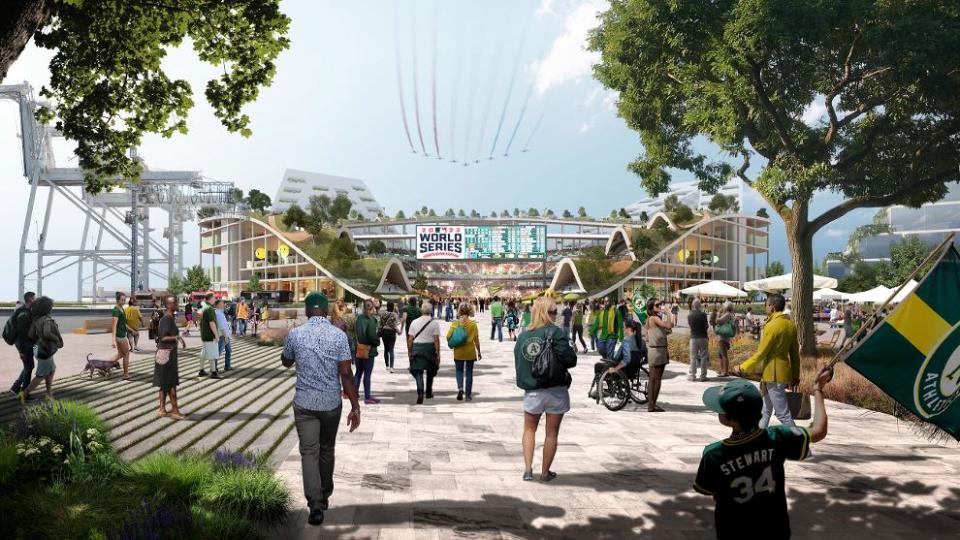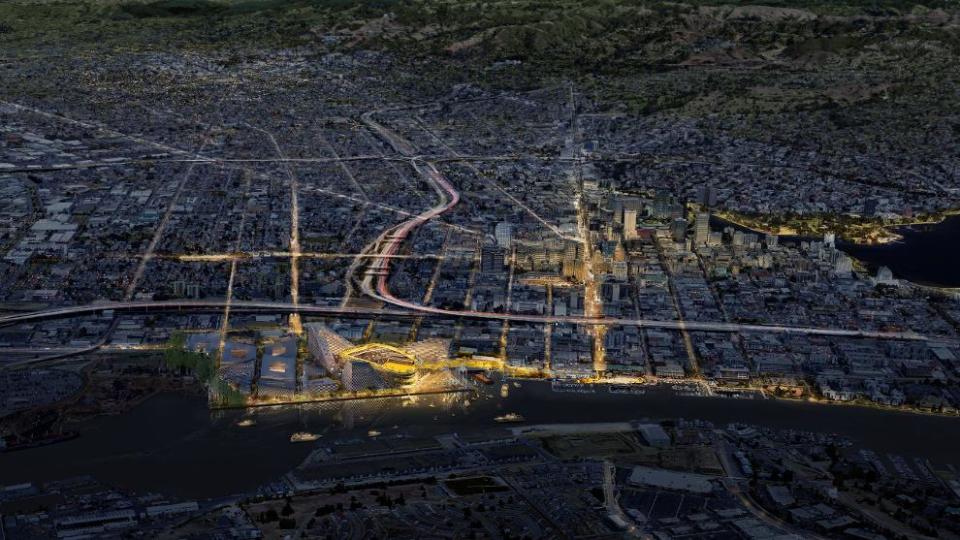The Oakland A's are trying to build baseball's ballpark of the future
The Oakland Athletics unveiled plans to build a stunning new waterfront ballpark Wednesday, a futuristic-looking stadium that would simultaneously be MLB’s smallest stadium and its most adventurous. The plan boasts high rises surrounding the ballpark, a rooftop public green space and transportation by aerial gondola.
It’s the latest turn in the decade-plus saga of the A’s trying to find a modern stadium, a tale that has ended in disappointment each time before this, which means there’s automatically more skepticism about what the A’s are trying to pull off. Some people would probably get more cautious after so many false starts, but the A’s are actually getting more ambitious. If they can pull it off, it’s the ballpark of the future.
The plan, according to the San Francisco Chronicle, calls for a 34,000-seat stadium to be built on 55 acres at Howard Terminal, which is near Oakland’s Jack London Square. That’s almost half the size of the current Oakland Coliseum, which the A’s share with the Oakland Raiders and which seats as many as 63,000. The stadium project would be 100-percent privately financed and, if everything goes to plan, would open for the 2023 season.
The Howard Terminal stadium is more modest in seat count than the Coliseum, but not in community impact. The A’s and the City of Oakland see the new stadium as the centerpiece of a new “waterfront district,” according to NBC Sports Bay Area, with restaurants, housing and other businesses to follow.
A second part of the plan calls for the A’s maintaining rights to the current Coliseum space and developing it as a community space. That would include keeping the baseball diamond intact and turning it into a community sports park and amphitheater, while also building a tech hub, retail spaces and housing. The plan would keep the Oracle Arena — the current home of the Golden State Warriors until they leave for a new arena in San Francisco — as a concert and event destination.
But the part of this that will attract the most attention from baseball fans is the new stadium — which is definitely different. Notice that the outfield and scoreboard are completely unlike anything else in MLB. Here are the renderings:






The Chronicle has more particulars about the ballpark, its inspiration and its surroundings:
Designed by the cutting-edge Danish architectural firm Bjarke Ingels Group, the ballpark is a deliberate throwback to the turn-of-the-century diamonds like Philadelphia’s Shibe Park (a.k.a. Connie Mack Stadium) where the A’s once played.
The ballpark itself would be nestled amid wedge-shaped high-rises — some as tall as 20 stories — with windows looking directly down on the playing field.
The site is too windy for the ballpark to be open to the water, but the stadium would include a publicly accessible rooftop park with sweeping views of the waterfront, Oakland and San Francisco.
“Instead of a ballpark that sits like a fortress, this will be open and accessible to the community at all times” when games aren’t taking place, Kaval said. “It will be a reason to live in the community, activate Jack London Square and become a great landmark in the Bay Area.”
The plan also includes an aerial gondola to shuttle 6,000 fans an hour from downtown Oakland over Interstate 880 and the railroad tracks to Jack London Square. While not shown, the plan would also feature a couple of pedestrian bridges over the tracks — though apparently not an auto bridge.
It all sounds great — well maybe not the no-auto-bridge part — but the rest sounds good, especially to A’s fans who have been starved for a cutting-edge ballpark for years. It’s also hard for A’s fans not to think about all the other times they’ve gotten their hopes up.
At one time more than a decade ago, the A’s were going to move to nearby Fremont but that deal fell through. Then they were aiming for a new stadium in San Jose, a move that was blocked by the San Francisco Giants, who have territorial rights in San Jose.
The A’s have entertained moving the team to places like Las Vegas or San Antonio. But the team’s current leadership has maintained its commitment to Oakland in recent years. Not only have the A’s centered their marketing around their history in Oakland, they’ve zeroed in on numerous stadium sites in the city limits.
The A’s first choice was a site owned by Oakland’s Laney College, but the school quickly nixed that idea when it refused to sell its land to the A’s. Now the A’s will enter into an environmental study on the Howard Terminal space. They also have until April to strike a deal to lease or buy the space from the Port of Oakland. And, of course, there’s the matter of private funding — which may be the biggest challenge of all. There’s no official price tag on the project yet, but estimates range from $1.5 billion to $2 billion, which feels like even more money when taxpayers aren’t helping.
All of which is to say this is a story we’ve seen a few times already with the A’s and their quest for a new ballpark. It looks nice, sure, and sounds great in theory. But there no shortage of hurdles before the finish line.
Maybe this is the time it finally goes right for the A’s. Maybe they’ll usher in the ballpark of the future and set the standard for the next generation of baseball stadiums. Everybody related to the A’s certainly deserves that this many years into the new-stadium struggle.
Maybe.
– – – – – –
Mike Oz is a writer at Yahoo Sports. Contact him at mikeozstew@yahoo.com or follow him on Twitter! Follow @MikeOz
More from Yahoo Sports:
• Redskins owner reaches peak hypocrisy with Foster
• University distributes pucks to defend against shooters
• Celtics’ ‘insane’ search for an identity
• LeBron reiterates desire to play with son in NBA
